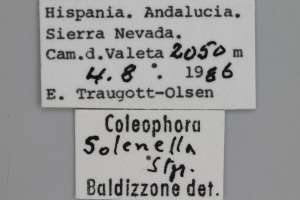2. Raupe, Raupensack
Ein hier gezeigtes Foto wurde am 12. Juni 2024 zu Coleophora gazella verschoben.
3. Diagnose
3.1. Geschlecht nicht bestimmt
3.2. Erstbeschreibung
4. Biologie
4.1. Nahrung der Raupe
- [Asteraceae:] Artemisia campestris (Feld-Beifuß)
Schon Staudinger (1859: 253) hatte in seiner Erstbeschreibung formuliert: „Bei Granada: Die Raupe im Mai auf Artemisia campestris.“ Nach Baldizzone (2019: 287) ist Artemisia campestris die einzige bisher bekannte Nahrungspflanze der Art. Artemisia santonicum wurde aus Ungarn gemeldet, doch gehören nach Takács et al. (2024) diese Sackfunde zu Coleophora gazella, so dass die Raupennahrungspflanze hier aus unserer Liste zu streichen ist, was nicht bedeutet, dass C. solenella nicht an Artemisia santonicum fressen könnte — es fehlen nur Belege dafür.
Angesichts des großen Verbreitungsgebiets des Falters von Spanien bis in die Mongolei ist mit der Nutzung weiterer Artemisia-Arten zu rechnen.
(Autoren: Erwin Rennwald & Jürgen Rodeland)
5. Weitere Informationen
5.1. Andere Kombinationen
- Multicoloria solenella (Staudinger, 1859) [so bei Anikin et al. (2017)]
5.2. Synonyme
- Coleophora lantosquella Millière, 1875 [Bestätigung der Synonymie durch Baldizzone (1979: 75-76)]
5.3. Unterarten
- Coleophora solenella tariata Reznik, 1975
5.4. Faunistik
Nach Baldizzone (2019: 287) reicht das Verbreitungsgebiet von Spanien (locus typicus: Granada) über Südfrankreich, Italien (nur sehr lokal im Piemont und Trentino-Alto Adige) und die Schweiz - mit riesiger Lücke - nach Kirgistan, die Tuva-Region im asiatischen Teil Russlands bis in die Mongolei. Das Vorkommen in der Schweiz erstreckt sich nach SwissLepTeam (2010) auf das Wallis und - überraschend - das Mittelland.
Der Erstnachweis für Ungarn von Szabóky & Takács (2021) ist zu streichen, denn nach Takács et al. (2024) handelt es sich um Coleophora gazella.
(Autoren: Erwin Rennwald & Jürgen Rodeland)
5.5. Literatur
- Anikin, V.V., Sachkov, S.A. & V.V. Zolotuhin (2017): "Fauna lepidopterologica Volgo-Uralensis": from P. Pallas to present days. — Proceedings of the Museum Witt Munich, Volume 7: 1-696; Munich and Vilnius.
- Baldizzone, G. (1979): Contributions à la connaissance des Coleophoridae. XII Les espèces décrites par J. de Joannis, P. A. J. Duponchel, P. Milliere, E. L. Ragonot et M. Vallot. — Alexanor 11 (2): 65-81, pl. I-XIII.
- Baldizzone, G. (2019): Fauna d’Italia. Vol. LIII. Lepidoptera Coleophoridae. - XVII + 907 S.; Milano (Calderini).
- Lectotypus-Festlegung: Baldizzone, G., Pensati, F. & P. Passerin d'Entreves (1999): Note su Coleophora solenella Staudinger, 1859 e sulla sua biologia (Lepidoptera; Coleophoridae). — Rivista Piemontese di Storia Naturale 20: 93-138. [PDF auf storianaturale.org]
- Будашкин, Ю. И., Рихтер, И. & Ю. Табель (2015): Новые находки молей-чехлоносок (Lepidoptera: Coleophoridae) в России и в Армении. — Эверсманния 41: 11–22.
- Резник, С. Я. (1975): Новые виды чехлоносок группы Coleophora vibicella Hb. (Lepidoptera, Coleophoridae) из Монголии [Reznik, S. J. (1975): New species of casebearers of the group Coleophora vibicella Hb. (Lepidoptera, Coleophoridae) from Mongolia]. — Насекомые Монголии 3: 370-394.
- Erstbeschreibung: Staudinger, O. (1859): Diagnose nebst kurzen Beschreibungen neuer andalusischer Lepidopteren. — Entomologische Zeitung 20 (7-9): 211-259. Stettin.
- SwissLepTeam (2010): Die Schmetterlinge (Lepidoptera) der Schweiz: Eine kommentierte, systematisch-faunistische Liste. — Fauna Helvetica 25. Neuchâtel (CSCF & SEG).
- Szabóky, Cs. & A. Takács (2021): New data to the Microlepidoptera fauna of Hungary, part XIX (Lepidoptera: Batrachedridae, Coleophoridae, Gracillariidae, Tortricidae). — Folia Entomologica Hungarica. Rovartani Közlemények, 82: 43–53. [PDF]
- Takács, A., Szabóky, C., Bozsó, M. & G. Lendvai (2024): First record of Coleophora gazella Toll, 1952 in Central Europe with notes on its biology. — Animal Taxonomy and Ecology online first: 1-11. [PDF auf akjournals.com]




![Vorkommen in Russland (europäischer Teil bis Manytsch-Niederung) [Sinev (2021)]](/res/img/flag/ru.gif)
![Vorkommen in Frankreich (europäisches Territorium ohne Korsika) [Vandromme et al. (2020): Liste systématique et taxinomique des Lépidoptères de France]](/res/img/flag/fr.gif)
![Vorkommen in Spanien (Festland) [Vives Moreno A. (2014)]](/res/img/flag/es.gif)
![Vorkommen in Italien (Festland und kleine festlandsnahe Inseln) [Baldizzone et al. (1995): Checklist delle Specie della Fauna Italiana 83]](/res/img/flag/it.gif)

![Vorkommen in der Mongolei [Locus typicus ssp. tariata]](/res/img/flag/mn.gif)





